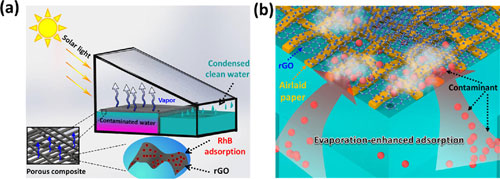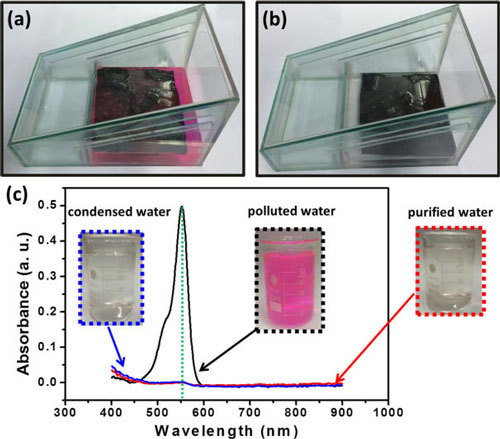| Posted: Jun 14, 2016 | |
Solar-driven water purification with multifunctional papers |
|
| (Nanowerk Spotlight) The potential impact areas for nanotechnology in water applications are divided into three categories: treatment and remediation; sensing and detection; and pollution prevention. Within the category of treatment and remediation, nanotechnology has the potential to contribute to long-term water quality, availability, and viability of water resources, such as through the use of advanced filtration materials that enable greater water reuse, recycling, and desalinization (read more: "Nanotechnology and water treatments"). | |
| Inspired by the multiple water purification mechanisms of water hyacinth, a group of Chinese researchers, led by Dr. Peng Tao and Dr. Wen Shang, has combined different decontamination techniques – adsorption, photocatalytic degradation, distillation – into a single paper-based composite system for water purification by using solar light as the clean energy input. | |
| These findings have been published in the May 26, 2016 online edition of Applied Materials & Interfaces ("Bioinspired Multifunctional Paper-Based rGO Composites for Solar-Driven Clean Water Generation"). | |
| Compared with water treatment with a single mechanism, the multifunctional composite reported in this work could significantly enhance the clean water generation efficiency and maximize the use of the broad-spectrum solar light in a facile and effective way. | |
 |
|
| (a) Schematic for clean water generation by floating air-laid paper-based rGO composite under solar irradiation, (b) schematic of adsorption removal of RhB enhanced by interfacial evaporation. (Reprinted with permission by American Chemical Society) (click on image to enlarge) | |
| "Scientifically, our work offers a good example for exploring multifunctional materials by taking inspiration from nature," Peng Tao an assistant professor at the Institute of Composite Materials at Shanghai Jiao Tong University, tells Nanowerk. "Technologically, the multifunctional composites and water-purification design we reported enables high-efficiency solar-driven water purification, which would be of particular importance for less developed areas of the world. At the same time, it would provide new thoughts on improving solar-driven water-purification technology, in particular, by taking the solar-heating effect into consideration." | |
| The scientific core of this novel work is the integration of adsorption removal, photocatalytic degradation and distillation driven by interfacial evaporation into a single floating paper-based composite for clean water generation. | |
| This composite material has homogeneously distributed reduced graphene oxide (rGO) nanosheets, which not only offer excellent adsorption removal capability due to their extremely large specific surface area and planar structure, but also have excellent light-to-heat conversion capability. The converted heat timely vaporizes the contaminated water, which can be condensed and collected as pure water. | |
| This upward interfacial evaporation, in turn, significantly speeds up the diffusion of contaminant towards the rGO adsorbents, thereby accelerating the adsorption removal. | |
| Moreover, these porous paper-based composites allow for easy deposition of photocatalysts such as titanium dioxide nanoparticles on the surface of the reduced graphene oxide nanosheets to take advantages of the aforementioned enhanced adsorption effect from the distillation process for efficient photocatalytic treatment of polluted water. | |
| The team fabricated a prototype water decontamination device to demonstrate the practical applicability of the prepared paper-supported rGO-TiO2 composite for efficient solar-driven clean water generation. | |
 |
|
| (a) Photograph of contaminated water treatment by floating PrGO-TiO2 composite within a homemade device before solar treatment, (b) photograph of clean water generation after solar treatment, (c) absorption spectra and photographs of polluted water, purified water, and condensed clean water. (Reprinted with permission by American Chemical Society) | |
| "This is the first time we were able to realize such multifunctional paper-based water-treatment at the air/water interface and report a new way to make better use of the broad-band of solar light through the solar-heating effect that so far has received little attention," says Tao. "We approached this problem by taking inspiration from nature. Natural biological systems such as the water hyacinth plant are experts in multifunctional clean water generation. The efficient interfacial solar-driven evaporation process we designed was inspired by the localized heating effect found in the leaves of this plant." | |
| Going forward, the researchers will optimize the structure and design to further improve performance of their device and explore other applications beyond water-treatment such as chemical synthesis and catalytic processes. | |
| The team's related work has previously been published in Small ("Bio-Inspired Evaporation Through Plasmonic Film of Nanoparticles at the Air/Water Interface") and Advanced Materials ("A Bioinspired, Reusable, Paper-Based System for High-Performance Large-Scale Evaporation"). | |
 By
Michael
Berger
– Michael is author of three books by the Royal Society of Chemistry:
Nano-Society: Pushing the Boundaries of Technology,
Nanotechnology: The Future is Tiny, and
Nanoengineering: The Skills and Tools Making Technology Invisible
Copyright ©
Nanowerk LLC
By
Michael
Berger
– Michael is author of three books by the Royal Society of Chemistry:
Nano-Society: Pushing the Boundaries of Technology,
Nanotechnology: The Future is Tiny, and
Nanoengineering: The Skills and Tools Making Technology Invisible
Copyright ©
Nanowerk LLC
|
|
|
Become a Spotlight guest author! Join our large and growing group of guest contributors. Have you just published a scientific paper or have other exciting developments to share with the nanotechnology community? Here is how to publish on nanowerk.com. |
|
